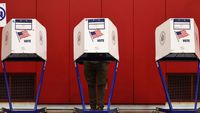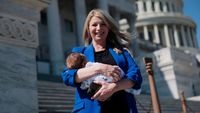Explore web search results related to this domain and discover relevant information.

We’re inching back toward an era where justice is out of reach for those who need it most.
These proposals would force Americans to produce specific government documents just to register to vote—an uphill climb for tens of millions who lack access to those papers but are still trying to exercise their rights, even as courts become less willing to hear their claims.Even before these proposals, courts had made it harder for individuals and civil rights groups to challenge discriminatory voting laws. When it becomes difficult to find a lawyer—and nearly impossible to win in court—bad actors are left free to suppress votes without fear of consequences.Over two decades, as the Supreme Court dismantled the VRA case by case, voter suppression has evolved. It’s become administrative—built on paperwork, confusion, inconvenience, and ever-changing rules. Americans now jump through a growing number of hoops just to vote.The ruling gave states broad leeway to pass restrictive laws, even those that disproportionately harm voters of color, as long as they could claim to be “preserving the integrity of its election process.” It was a significant blow to Section 2 of the VRA, the main tool left to fight voter suppression in court.

In Virginia, one piece of proposed legislation aims to allow citizens to demand forensic audits of results, which would then be presented to a jury of “randomly selected residents,” who could vote to invalidate the election. Of the 150 bills, more than half aim to limit access to mail-in ...
In Virginia, one piece of proposed legislation aims to allow citizens to demand forensic audits of results, which would then be presented to a jury of “randomly selected residents,” who could vote to invalidate the election. Of the 150 bills, more than half aim to limit access to mail-in voting which gained popularity during the coronavirus pandemic.Lawmakers in 32 states across the US have introduced or pre-filed at least 150 bills aimed at making it harder to vote, according to a new analysis from the liberal-leaning Brennan Center for Justice at New York University’s law school.People cast their vote on Election Day at P.S. 11 Purvis J.The restrictive voting bills are part of an ongoing Republican-led push to change election laws following record turnout in the 2020 presidential election and unfounded claims of widespread voter fraud.
A registered voter who has moved from the county in which he or she is registered , to a new county of residence in Texas, and who will not be registered to vote in the new county on or before March 1, 2022, may be eligible to vote a “limited ballot.
A registered voter who has moved from the county in which he or she is registered , to a new county of residence in Texas, and who will not be registered to vote in the new county on or before March 1, 2022, may be eligible to vote a “limited ballot.” Limited ballots may be voted in person or by mail in the new county of residence in the upcoming March 1, 2022 Primary Election under the following conditions:The district chart indicates each district race in your county, as well as the district races in other Texas counties. The district chart is a tool to assist you in determining the races for which eligible voters may vote when applying for a limited ballot. The district chart does not detail precincts that are in common if your county contains only part of a district.Ask the voter to complete an Application for Limited Ballot (PDF) and complete an Application for Ballot by Mail (PDF). Instruct the voter to mail them together to the Early Voting Clerk.Indicate the district offices for which the voter is entitled to vote on the Application for a Limited Ballot. Prepare the correct ballot for the voter.

But the president’s authority is limited. Last month, a federal judge blocked his executive order requiring documentary proof of citizenship to vote.
We explore President Trump’s effort to eliminate mailed ballots and voting machines.President Trump may have won the presidency twice, but he still thinks the electoral system is rigged. In his view, the safest way to run a democracy is to vote at your local precinct, and only on Election Day. He believes without evidence that two popular methods are rife with fraud: mailed ballots and voting machines.This effort is years old — and based largely on conspiracy theories that emerged during the pandemic. (I covered them, alongside voting tech, extensively at the time.) But a change to how we vote could have a huge impact on elections, discarding decades of settled election law.You could vote absentee for decades, but many more people began casting their ballots this way during the 2020 election. It was a way to pick your leaders while avoiding Covid. It remains popular, presumably for convenience: You don’t have to call out of work or brave bad weather to exercise your civic right.
Definition of limited-voting stock in the Financial Dictionary - by Free online English dictionary and encyclopedia. What is limited-voting stock? Meaning of limited-voting stock as a finance term. What does limited-voting stock mean in finance?
Definition of limited-voting stock in the Financial Dictionary by The Free DictionaryCommon stock designated by the publicly-traded company issuing it as having fewer voting rights than other common stocks. This gives a shareholder of limited-voting stock less control over the company than he/she would otherwise have. For example, a company can designate its limited-voting stock as having half a vote and its regular common stock as having one vote.Limited-voting stock is beneficial for the board of directors and the company's management, as it allows the company to raise financing from limited-voting stockholders while giving them less control over the company.A class of stock that provides its holders with smaller than proportionate voting rights in comparison with another class of stock issued by the same firm. Limited-voting shares allow another class of stock effectively to control the election of a firm's directors even though the limited-voting shareholders may have contributed a majority of the firm's equity capital.

In those years, African Americans ... reprisals, and physical violence when they tried to register or vote. As a result, African-American voter registration was limited, along with political power....
In those years, African Americans in the South faced tremendous obstacles to voting, including poll taxes, literacy tests, and other bureaucratic restrictions to deny them the right to vote. They also risked harassment, intimidation, economic reprisals, and physical violence when they tried to register or vote. As a result, African-American voter registration was limited, along with political power.(a) The Congress finds that the requirement of the payment of a poll tax as a precondition to voting (i) precludes persons of limited means from voting or imposes unreasonable financial hardship upon such persons as a precondition to their exercise of the franchise, (ii) does not bear a reasonable relationship to any legitimate State interest in the conduct of elections, and (iii) in some areas has the purpose or effect of denying persons the right to vote because of race or color.(c) (1) The terms "vote" or "voting" shall include all action necessary to make a vote effective in any primary, special, or general election, including, but not limited to, registration, listing pursuant to this Act, or other action required by law prerequisite to voting, casting a ballot, and having such ballot counted properly and included in the appropriate totals of votes cast with respect to candidates for public or party office and propositions for which votes are received in an election.EnlargeDownload Link Citation: An act to enforce the fifteenth amendment to the Constitution of the United States and for other purposes, August 6, 1965; Enrolled Acts and Resolutions of Congress, 1789-; General Records of the United States Government; Record Group 11; National Archives View All Pages in the National Archives Catalog View Transcript This act was signed into law on August 6, 1965, by President Lyndon Johnson.


What should win the 2025 Emmy for Outstanding Limited or Anthology Series? Cast your vote in our poll!
CAST YOUR VOTE! ... TVLine Asks: Which SNL Exit Hurts the Most? What Brings Dr. Halstead Back to Chicago Med? And More! ... For the second year in a row, Netflix has thrown a last-minute wrench into the Emmy race for best limited or anthology series.CAST YOUR VOTE! Emmys 2025 Poll: Who Should Win for Supporting Actor in a Limited Series?CAST YOUR VOTE! Emmys 2025 Poll: Who Should Win for Supporting Actress in a Limited Series?CAST YOUR VOTE! Emmys 2025 Poll: Who Should Win for Lead Actor in a Limited Series?
Limited Voting. Like the other systems described in this factsheet, limited voting uses multi-seat electoral districts -- meaning districts that elect two or more representatives to a legislature. With limited voting, voters have fewer voters than there are seats.
This sheet examines the pros and ... States: limited voting, cumulative voting (in its two major variations) and choice voting. Summary: Choice voting promotes proportional representation, allowing minority and majority perspectives to win representation in proportion to their relative voting strengths.This sheet examines the pros and cons associated with the three most commonly-used proportional / semi-proportional systems in the United States: limited voting, cumulative voting (in its two major variations) and choice voting. Summary: Choice voting promotes proportional representation, allowing minority and majority perspectives to win representation in proportion to their relative voting strengths. Although best accompanied by a straightforward voter eduction effort, choice voting is an easy system for voters and reduces demands for complex voting strategies like bullet-voting.Limited Voting. Like the other systems described in this factsheet, limited voting uses multi-seat electoral districts -- meaning districts that elect two or more representatives to a legislature. With limited voting, voters have fewer voters than there are seats.For example, in a five-seat district, each voter might be allowed to cast two votes, and the winners are the five candidates who receive the highest totals of votes. With limited voting, the fewer votes each voter has, the more likely political minorities will win fair representation � when voters are limited to one vote, the victory threshold is as low as it is with cumulative voting and choice voting.

"But knowing that so many lives were on the line for that vote — I needed to be there for my constituents." The bill is limited to new moms and their spouses and would allow them to vote by proxy for up to 12 weeks — that could include time during and after the pregnancy, and for spouses ...
"But knowing that so many lives were on the line for that vote — I needed to be there for my constituents." The bill is limited to new moms and their spouses and would allow them to vote by proxy for up to 12 weeks — that could include time during and after the pregnancy, and for spouses who need to help partners or infants dealing with medical issues.GOP leaders accused of making threats to block bill to let new moms vote remotely Lawmakers from both parties teamed up to force a House vote on a measure allowing new parents to vote by proxy for 12 weeks, but House Speaker Mike Johnson opposes it on Constitutional grounds.Luna is teaming up with Colorado Democratic Congresswoman Brittany Pettersen, the 13th lawmaker to deliver a baby while in office. They used a procedural tool called a discharge petition to gather support from a majority of House members — 218 — to force a vote on their measure, which would allow new parents to vote by proxy for 12 weeks around the birth of a new child.Luna says GOP leaders and their allies are using a mix of threats and horse trading to try to get lawmakers to derail that vote. She says she was even offered a committee slot on a panel that she was initially rejected from earlier this year.

In those years, African Americans ... reprisals, and physical violence when they tried to register or vote. As a result, African-American voter registration was limited, along with political power....
In those years, African Americans in the South faced tremendous obstacles to voting, including poll taxes, literacy tests, and other bureaucratic restrictions to deny them the right to vote. They also risked harassment, intimidation, economic reprisals, and physical violence when they tried to register or vote. As a result, African-American voter registration was limited, along with political power.(a) The Congress finds that the requirement of the payment of a poll tax as a precondition to voting (i) precludes persons of limited means from voting or imposes unreasonable financial hardship upon such persons as a precondition to their exercise of the franchise, (ii) does not bear a reasonable relationship to any legitimate State interest in the conduct of elections, and (iii) in some areas has the purpose or effect of denying persons the right to vote because of race or color.(c) (1) The terms "vote" or "voting" shall include all action necessary to make a vote effective in any primary, special, or general election, including, but not limited to, registration, listing pursuant to this Act, or other action required by law prerequisite to voting, casting a ballot, and having such ballot counted properly and included in the appropriate totals of votes cast with respect to candidates for public or party office and propositions for which votes are received in an election.EnlargeDownload Link Citation: An act to enforce the fifteenth amendment to the Constitution of the United States and for other purposes, August 6, 1965; Enrolled Acts and Resolutions of Congress, 1789-; General Records of the United States Government; Record Group 11; National Archives View All Pages in the National Archives Catalog View Transcript This act was signed into law on August 6, 1965, by President Lyndon Johnson.
Learn how campaign contribution limits, accessibility rules, and other federal election laws help protect your voting rights and the election process.
Learn how campaign contribution limits, accessibility rules, and other federal election laws help protect your voting rights and the election process. Each state sets its own voter ID rules. And most require voters to bring identification to vote in person.In the U.S., no one is required by law to vote in any local, state, or presidential election. Federal law puts limits on campaign contributions to candidates for president and Congress.Learn about contribution limits and campaign financial reporting rules. If you witness or suspect election crimes, you can report them. Learn where to report voter fraud and voting rights violations.Know the voter ID laws in your state before going to the polls.

Star Citizen Launches Limited Free Fly So You Can Vote On Which Community-Picked Ship Is The Best | MMORPG.com Star Citizen's Ship Showdown is currently running to determine which ships are the fans' best of the best, and now, anyone can fly the top eight.

Some common obstacles include voter ID laws, inconvenient polling locations, and limited early voting options, which disproportionately affect low-income communities and minority populations.
In the context of politics, “low propensity voters” refers to individuals who are eligible to vote but have a history of infrequent participation in elections, …In the context of politics, “low propensity voters” refers to individuals who are eligible to vote but have a history of infrequent participation in elections, often skipping midterms, primaries, or even general elections.Targeting low propensity voters requires a different set of tactics: more personalized outreach, education on the voting process, and often, resources devoted to tackling logistical barriers like transportation to the polls.But low-propensity voters are not an automatic capture for Democrats in presidential elections. Many don’t vote in the first place because of disgust with the role of money in politics and the level of self-dealing by seemingly greedy candidates and officeholders.
Note: The links displayed within the forms section access PDF (Portable Document Format) files which can be accessed using the Adobe Acrobat Reader. Visit Adobe.com to download your copy of Acrobat Reader. All PDF documents featured on this page are configured to print out on legal size paper ...
A registered voter who has moved from the county in which he or she is registered to a new county of residence in Texas, and who will not be registered to vote in the new county on or before November 8, 2016 may be eligible to vote a “limited ballot” in person or by mail in the new county ...
A registered voter who has moved from the county in which he or she is registered to a new county of residence in Texas, and who will not be registered to vote in the new county on or before November 8, 2016 may be eligible to vote a “limited ballot” in person or by mail in the new county of residence in the upcoming November 8, 2016 General Election under the following conditions:The district chart (PDF) indicates each district race in your county, as well as the district races in other Texas counties. The district chart is to assist you in determining the races for which eligible voters may vote when applying for a limited ballot. The district chart does not detail precincts that are in common if your county contains only part of a district.Mail the voter their limited ballot. See the next section on casting/counting limited ballots. Once the marked mail ballot is returned, add the voter to the Poll List of Mail Voters (PDF).After the election, notify the voter registrar of the former county that the voter has voted under this procedure (Form 5-29 (PDF)). This will allow the voter registrar of the former county to cancel the voter's registration. We recommend using similar methods if you are creating a “federal office only” ballot pursuant to Chapter 114 of the Code. If you have any questions regarding limited balloting, please contact the Elections Division at 1-800-252-2216.
Voters have more than one vote, but less votes than the number of seats to be filled. When setting up the electoral system, the designers would decide how many representatives ea
In Gibraltar, each voter has 10 votes and each area elects 17 representatives. The limited vote was used to elect MPs for several large cities in the UK between 1867 and 1885.Each voter had two votes and each constituency elected three representatives. The Japanese Lower House used a variant of the Limited Vote called the Single Non-Transferable Vote (SNTV) between 1948 and 1993.On polling day the voter puts as many Xs as they are allowed next to the names of the candidates they want to elect. The limited vote is supposed to ensure the same party can’t win all the positions available as voters have fewer votes than positions available, but this can be circumvented with sufficient organisation.The Limited Vote is a form of First Past the Post with more than one winner.


Conservative courts, helmed by Trump judges, are limiting who can sue for voting rights, the scope of the Voting Rights Act, and which courts can hear claims.
Courts are narrowing who can bring voting rights suits, who can be sued, and who can judge them.While the three suits deal with different provisions of Texas election law, all three asked for the federal courts to issue an injunction against unconstitutional burdens to voting that plaintiffs allege were imposed by Texas lawmakers. Those alleged burdens include lengthy wait times that would result from eliminating straight ticket voting, the new hoops voters have to jump through to cast mail-in ballots, and the process that Texas has implemented to verify mail-in ballots.The Justice Department has previously been able to count on other groups serving as a kind of backup by mounting their own challenges to voter discrimination, but if Rudofsky’s reasoning prevails, that support would be off the table.Meanwhile, at least four Supreme Court justices appear open to the idea that state courts lack the power to hear cases challenging congressional gerrymandering, no matter the effect on minority voters. The supposed “independent state legislature” doctrine argues that under the Constitution, only state lawmakers can set election laws, not governors or state court judges.
Under plurality block voting, voters can cast up to three votes, though it's not mandatory. Under limited (block) voting, voters can cast a maximum of two votes.
Partial block voting, also known as limited voting, operates similarly to plurality-at-large voting. However, in partial block voting, each voter casts fewer votes than the number of candidates to be elected. This process enables reasonably sized minorities to achieve some representation, preventing a simple plurality from sweeping every seat.Under unlimited block approval voting, voters can select any number of candidates. Under limited block approval voting, voters can cast up to six votes, twice the number of winners.Under plurality block voting, voters can cast up to three votes, though it's not mandatory. Under limited (block) voting, voters can cast a maximum of two votes.Under the single non-transferable vote, the three most popular candidates based on voters' initial preferences are elected, irrespective of party affiliation. In limited voting, it is probable that the party with a plurality secures two seats (reflecting the number of votes each voter has), while the minority party gains the remaining seats.


President Trump pledged to eliminate mail-in voting and the use of voting machines following a meeting with Russian President Vladimir Putin.
While it might be clear to most that the Russian autocrat was quite clearly making a play to stroke Trump’s ego, the president has pushed Republicans at home to restrict access to mail-in and early voting, with significant success. Since 2020, at least 29 states implemented more stringent restrictions on voter registrations and identification requirements, or attempted to limit early and absentee voting.There is no evidence that the use of mail-in ballots or digital voting machines is conducive to widespread electoral fraud. Though mail-in voting has historically skewed Democratic, Republicans rely on it as well, including in states like Florida, where Trump voted early last year.“I am going to lead a movement to get rid of MAIL-IN BALLOTS, and also, while we’re at it, Highly ‘Inaccurate,’ Very Expensive, and Seriously Controversial VOTING MACHINES,” the president wrote, referencing conservatives’ disproven claims and conspiracies regarding voter fraud in the 2020 election, which he lost.“Remember, the States are merely an ‘agent’ for the Federal Government in counting and tabulating the votes. They must do what the Federal Government, as represented by the President of the United States, tells them, FOR THE GOOD OF OUR COUNTRY, to do,” he added.
Limited voting (also known as partial block voting) is a voting system in which electors have fewer votes than there are positions available. The positions are awarded to the candidates who receive the most votes. In the special case in which the voter may vote for only one candidate and there ...
They cannot cast a third although there are three seats being contested. Each vote counts as one towards the total for the candidate voted for. Limited Voting frequently enables minority groupings to gain representation – unlike first past the post or bloc voting systems.For example, in Voterville 54% of electors support the Blue Party while 46% support the Red Party. The Blue Party would win all three seats with bloc voting and also under first past the post assuming an even distribution of support across the town, and the Red Party would win no representation. With limited voting the Red Party would usually win one seat.Assuming 20,000 electors in the town cast two votes each and the Blue party getting 54 percent of the votes and the Red party getting 46 percent, the results might be: Thus two parties obtain representation. But a minority getting representation (at least one seat) under limited voting is not guaranteed, since a sectional vote may not be effective due to the number of candidates fielded and the manner in which votes are cast for party candidates.By fielding three candidates the Blue Party split their vote and lost out, despite having a clear majority of voter support in the town. As can be seen from this example, limited voting does not always produce proportional representation.




